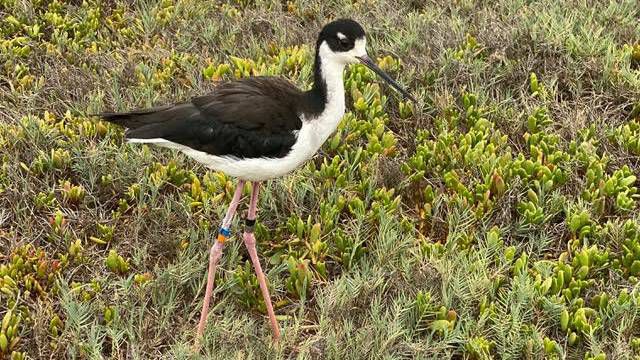HONOLULU — A new report looks at how solar panel facilities in Hawaii might impact endangered birds, and it offers solutions to mitigate harm.
Hawaii has a goal to only use clean energy by 2045. While renewable energy sources such as windmills and solar panels will help reduce our reliance on fossil fuels, which is accelerating climate change, they may negatively impact wildlife.
Researchers David Duffy, who is a professor at the University of Hawaii at Manoa, and Jay Penniman, who is the manager of the Maui Nui Seabird Recovery Project, co-authored the new report.
“We completely support the use of solar energy and the development of photovoltaic systems to generate electricity,” said Penniman in an interview Thursday with Spectrum News Hawaii. “However, it is pretty well documented that industrial scale and utility scale solar facilities have had on the mainland a very serious effect on some bird populations.”
“We feel that it's imperative that as we develop them here, since we have the largest number of endangered species of any place in the world … that we take into consideration what we can do to minimize and to mitigate any impacts that solar facilities will have on wildlife,” he added.
Currently, 70 solar facilities are in operation or development in Hawaii. The first solar facilities were built in the state starting in 2008.
The report was intended to ensure that bird impacts are considered before more solar energy facilities are constructed and the industry becomes adversely affected by bird collisions.
Hawaii is home to a large number of endangered birds, and many conservationists are already working to keep these avian animals from going extinct. Last year, the Hawaii Supreme Court heard a case regarding endangered hoary bats, which were being harmed or killed by a windmill facility in Kahuku, so similar cases might be brought if solar facilities in Hawaii impact birds.
Five endangered waterbirds, three endangered seabirds and the endangered Hawaiian owl, also known as the pueo, were identified in the report as susceptible to impacts from solar facilities.
The five waterbirds include the alae ula (Hawaiian common gallinule), which count 1,000 in the remaining population; the koloa maoli (Hawaiian duck), of which there are about 1,000 remaining; aeo (Hawaiian stilt) with about 1,000 remaining; nene (Hawaiian goose), of which there are about 3,000 remaining; and the alae keokeo (Hawaiian coot), which count about 2,000 remaining in its population. An alae keokeo has already been found dead at a solar field on Kauai.
The three seabirds include the ao (Newell’s shearwater), uau (Hawaiian petrel), and akeake (Band-rumped storm-petrel), the latter of which is a distinct Hawaiian subspecies.
Additionally, the report identified 15 waterbirds and 17 shorebirds that may be impacted.
A major harm from solar energy facilities is the lighting that surrounds them, which can attract birds and lead them to being “grounded," when lights distract flying birds and scramble their thinking.
“They fly round and round and round very fast,” Penniman said. “They get exhausted and they crash — either into a structure or onto the facility.”
Birds must be retrieved by avian experts in order to become reoriented and airborne again. If they are not, they have a high mortality rate, as they are often run over by a car or killed by cats, rats or mongooses.
“When I’ve picked them up after they’ve gone through that, they’re just completely exhausted, their bills open, they're panting, their hearts beating extremely rapidly,” he said.
Young fledgling birds are most susceptible to this phenomena, Penniman said. The ao and uau are also particularly vulnerable to light attraction, with more than 10,000 birds grounded since the late 1970s on Kauai.
The other type of light pollution that birds may be harmed by is caused by polarization and is known as the “lake effect,” when birds land on solar fields after mistaking them for bodies of water, which leads to injury or death.
Both of these types of light pollution have caused significant amounts of bird mortalities at solar facilities on the mainland.
Birds also collide with solar panels when they reflect the sky and are mistaken as a safe flying space. They also might collide with power lines and other infrastructure connected to the facility.
While there’s already evidence of this harm on the mainland, the report highlights that Hawaii’s isolation and unique ecosystem may amplify these consequences.
Many of the report's recommendations to mitigate bird impact focus on design solutions, and the report encourages that these be considered before constructing solar facilities as opposed to retrofitting them at a later date.
The advice includes avoiding building in areas that are regularly used flight paths or windy slopes that are used by migrating birds to become airborne. It also recommends putting in fences for predator control around solar facilities where birds might be grounded.
Another recommendation is to position lighting so that it won’t be reflective on certain surfaces, as well as not using lighting during construction that is shining out and using lighting that is warm-color temperatures, which is less destructive to seabirds.
According to the report, efforts should be made to reduce the attractiveness of solar panels to birds, which might be done by using white borders around solar panels, using technology to mimic the sounds of predators to scare off birds and tilting solar panels upright at night, making them look less like water.
The report also said markers should be attached to wires in order to mitigate collisions.
Finally, there is a need to monitor solar facilities, and it should be a requirement for planning permits, the authors said. This would include systematically walking around and checking for downed birds or carcasses.
The report also looks to Europe, where there have been proposals for revenue from solar facilities to be used to restore nearby wetlands or support endangered conservation and research projects.




